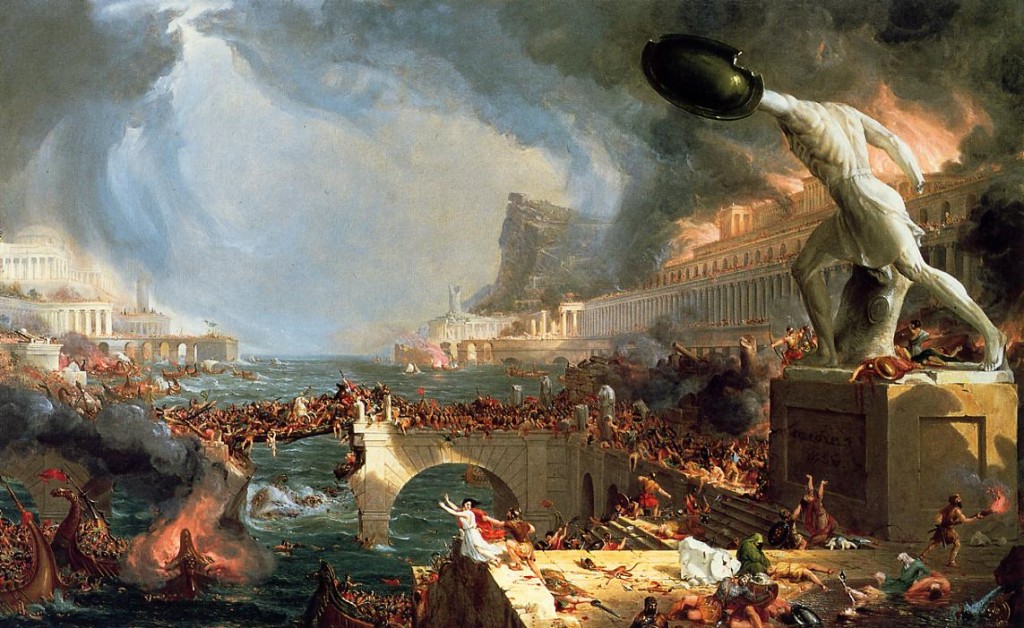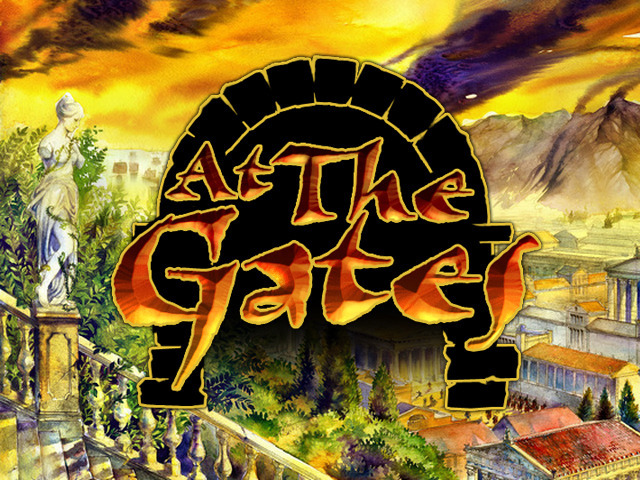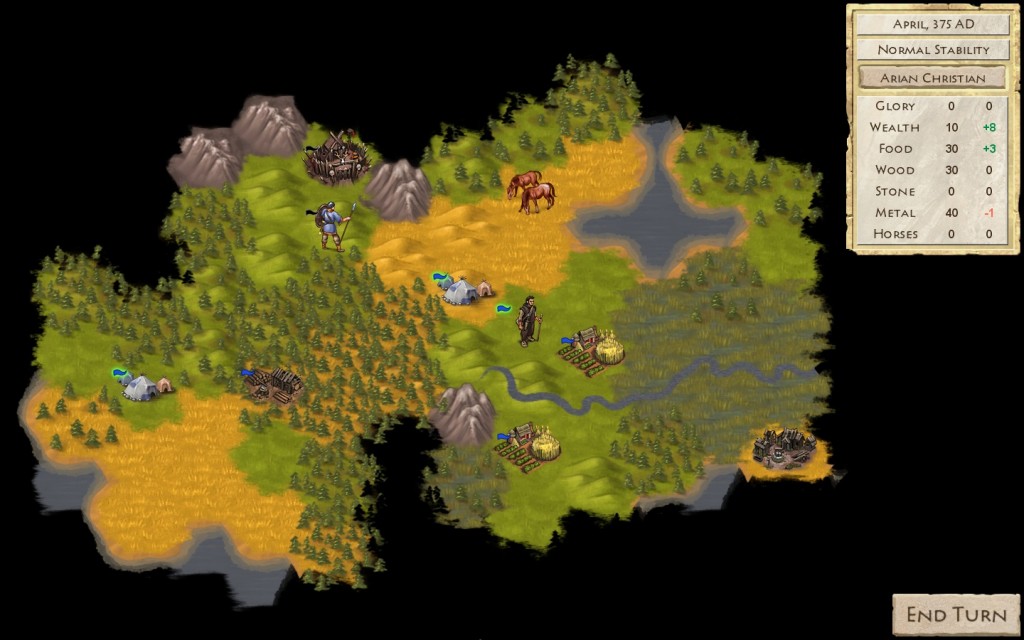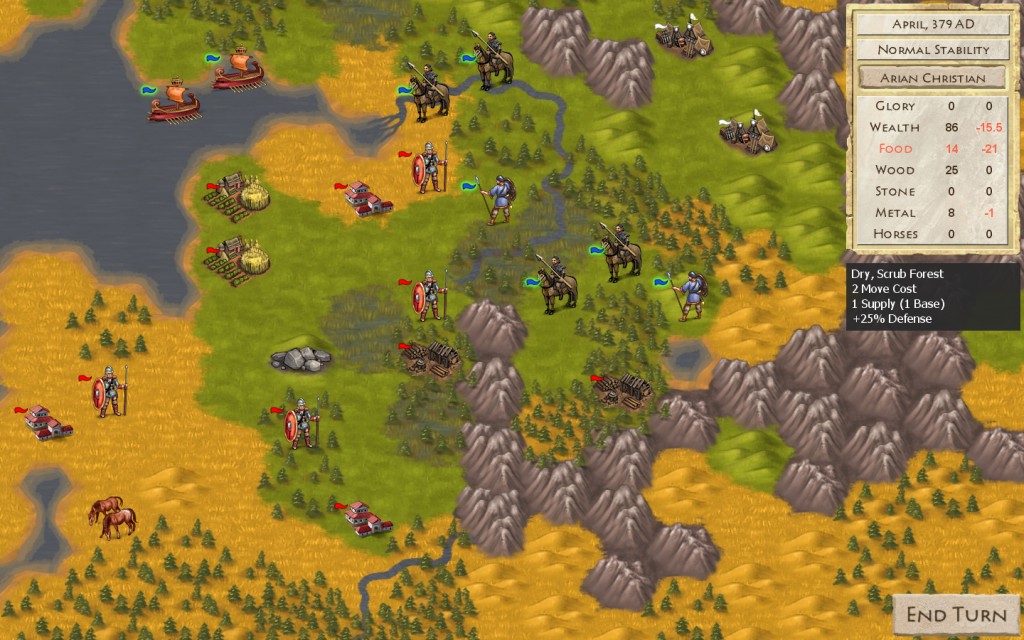Civilization V designer Jon Shafer has unveiled his latest project on Kickstarter: At the Gates, a 4X strategy game that casts the player as a barbarian chief out to pick the carcass of the crumbling Roman Empire. The game sets out to fix one of the biggest problems in strategy gaming, the boring middle/late game, and its promised features include:
1. An emphasis on supply: armies will have only a limited capacity to live off the land, making them reliant on supply trains and friendly cities;
2. A dynamic map: resources will deplete over time (placing players under greater and greater pressure as the game goes on); seasons will affect the map as rivers freeze and food stockpiles dwindle during winter;
3. Asymmetric non-player factions: the Romans are still on the map, play by different rules to the barbarians, and won’t give up without a fight.
This all sounded very interesting to me, and Jon was kind enough to sit down for an email interview. Read on:
Peter Sahui: First off, you’ve cited Unity of Command’s emphasis on logistics as an inspiration for At the Gates. I was wondering what some of your other inspirations (not just video games – board games, fiction and non-fiction books, etc) might have been?
Jon Shafer: One of the most basic inspirations for making a Roman-era game was hearing one of my designer friends talking about the fall of Rome scenario he was working on. I didn’t lift any ideas directly from the scenario, but it got me thinking about “reverse” mechanics, where the game gets harder the longer you play, rather than easier.
Prior to that, the same fellow actually introduced me to the superb History of Rome podcast, which I’d been listening to for a few months prior to starting work on ATG. So I had a lot of Rome-ish-ness in my head already. These factors combined with my desire to make a game where the map changed somehow over time, and ATG was born!
Oh, and I’d be remiss to not mention the Civilization series, as obvious at that answer is!
PS: You’re best known as the designer of Civilization V, a game I enjoyed but that had its fair share of issues at launch. What are some of the lessons you’ve learned from past projects, and how will you apply them to ATG?
JS: I actually have a 3,000-word article coming out around lunchtime tomorrow on this very subject, so I think I’ll just leave you in suspense until then – stay tuned! (Update: here’s the article!)

PS: ATG plans to spice up the mid/late game by forcing players to migrate across the map as they use up their resources. What other mechanisms do you have in mind to keep the mid/late game interesting? Will, for instance, new barbarian tribes gatecrash the midgame along the lines of the Mongols in Medieval: Total War and Crusader Kings 2?
JS: We’re not planning on any new factions appearing, but there are definitely changes over the course of a single game. You already noted the depletion of resources, which very much determines the arc of the game. As you run out you have to move on. In the late-game resources will be running out across the entire map, and the pressure is really on to wrap things up and win the game.
Other changes include the gradual weakening of the two Roman factions. At the start of game they’re both basically superpowers that you really don’t want to mess with. But over time they’ll fight one another and the barbarians, they’ll be hit with random events that weaken them, kill off their emperors, etc. So there’s a shift of fearing and wanting the favor of the Romans over to being equal partners, and then they become the targets.
The Romanization system also spices things up as the game goes on. In one sense it’s similar to a typical tech tree, but players will have the ability to completely re-allocate what perks they’ve chosen, giving them the ability to completely switch gears later on. This will probably be necessary as well, as the game is pretty tough and overcoming the challenges one will face will require some clever planning.
PS: The other bane of the strategy mid/late game, I think, is micromanagement. How will ATG address this?
JS: The real focus on ATG is on strategy over tactics. There’s certainly some measure of micromanagement in the game, but it’s a completely different scope from Civ. There are no Worker units to order around, no population to allocate in cities, no production or research meters to wait on, etc.
Instead, there are empire-wide resource stockpiles, settlements which can build units but not much else and aren’t fixed in one location, an emphasis on the supply system in combat, and so on. We’re very much making a concerted effort to get away from some of the fiddly bits that are common in other 4X games.
PS: Players win ATG by capturing Rome or Constantinople, and you’ve stated that when the Romans eventually falter, “the game becomes a mad dash to be the first to finish them off.” For me, this brought back happy (and tense!) memories of realm divide in Total War: Shogun 2 and, going further back, the race for the capital in Emperor of the Fading Suns. Could you elaborate a bit on how this will work? Will there be a victory timer so that the other players have a grace period to grab Rome/Constantinople for themselves?
JS: Right now my thinking is that the barbarian tribes will have to earn a certain amount of “Glory” (score, basically) before they can achieve victory. The purpose of this is to prevent players from rushing towards Rome/Constantinople in the first fifty turns of the game, and instead have to “achieve something” first.
The basic idea is that players have to find various means of building up their kingdom, whether through conquest, diplomacy, Romanization, etc. Once you’ve established yourself the objective then shifts. Given that we’re still fairly early in development there’s a good chance this will all completely change, but that’s how the game works right now at least!
PS: Speaking of Emperor of the Fading Suns, the ATG main theme reminded me a little of that game! Who’s the composer, and will he/she also tackle the rest of the soundtrack? Any chance of adding a Christopher Tin stretch goal?
JS: Hahaha, we’ll see!
The composer of our theme is Geoff Knorr, who also composed several amazing pieces for Civ 5. Our future plans regarding the soundtrack in ATG are honestly up in the air right now – the direction we go there is very much tied to how the Kickstarter campaign wraps up!
PS: How customisable will the game be (think Civ-style) – e.g. map sizes, resource abundance, whether difficulty will be tweakable at a level beyond easy/normal/hard, turn limits, etc? Can I do a large map with slow speed, abundant resources, with a hard AI and no AI resource boosts? Or a small map with fast speed, normal AI with a 50% AI resource bonus?
JS: We’d love to add a lot of customization options, but we’re trying to remain focused on the core gameplay experience for now. If the Kickstarter continues doing as well as it has so far it’s possible we’ll add that as a stretch goal and bring on extra help to add these features of this kind.
PS: Do you have any final message for the readers?
JS: Just that I’m very excited to finally be able to talk about ATG with you all! If anyone has any other questions I’m more than happy to answer them. You can either leave a comment on our Kickstarter page or email me directly at jon.shafer@conifergames.com.
PS: Thanks for your time, Jon!
The At the Gates Kickstarter has already reached its target goal of $40,000, but will remain open until 8 March.
At the Gates images taken from the official website and Kickstarter page.
Discover more from Matchsticks for my Eyes
Subscribe to get the latest posts sent to your email.



1 thought on “At the Gates Q&A with Jon Shafer!”